Tannins in water aren’t typically harmful to health, but tannins-contaminated water has a musty odor and may taste bitter. It might also take on an unpleasant murky yellow or brownish tint.
Our water treatment experts have years of first-hand experience in testing and reviewing water filtration systems. In this guide, we’ve ranked our top-recommended methods of removing tannins from water, based on our own experience and scientific data.
📌 Key Takeaways:
- The best way to remove tannins from your tap water is with a water filter that can trap, block, or adsorb tannins, preventing them from passing through with the water molecules.
- Filters that can remove tannins include ion exchange systems, reverse osmosis filters, oxidation systems, activated carbon filters, and ultrafiltration membranes.
- KDF filters, conventional water softening, ceramic filters, and boiling water are NOT effective methods of sediment removal.
Before we get started, it’s important to know that there are dozens of different types of tannins (over 8,000, although not all of these are found in water), and one filtration media doesn’t necessarily cover all situations.
Many people find that combining several methods of water treatment, such as activated carbon with anion exchange, offers a more comprehensive tannins removal solution that best fits their circumstances.

Table of Contents
🔁 Anion Exchange
Tannins have a slight negative charge, so another effective method to reduce them in water is to use an anion exchange resin.
The best way to use anion exchange to address tannins in water is with a point-of-entry system. This system is similar to a water softener but uses a positively charged anion resin (to attract the negatively charged tannins) rather than a water softener’s negatively charged cation resin (to attract positively charged hardness minerals).
You can also buy anion exchange filter cartridges, but these are often for POU applications and therefore won’t protect your plumbing from this contaminant. They also become clogged quickly.
Note: We’ve seen some sources mistakenly say that water softeners can remove tannins because they use ion exchange. However, water softeners use cation exchange, meaning that they exchange positively charged ions. Tannins are anions, meaning that they’re negatively charged and can only be removed with an anion resin. Some manufacturers offer systems with a mixture of cation and anion exchange resin, so you get the best of both worlds. You could remove half the cation exchange resin in your water softener and replace it with anion resin to address hardness minerals and tannins.
How it Works
Anion exchange media is typically stored in a large tank. This special chloride-form resin is pre-loaded with sodium ions, which are exchanged with tannins and other anions as water flows through the tank.
Once all the ions are exchanged, the resin will regenerate, replenishing the sodium and flushing out the accumulated tannins. This ensures the anion exchange process can continue without the need for manually cleaning or replacing the rein.
An added bonus of an anion resin is that it isn’t only capable of tannin removal – it’s also used for reducing nitrate, arsenic, and sulfate in water.
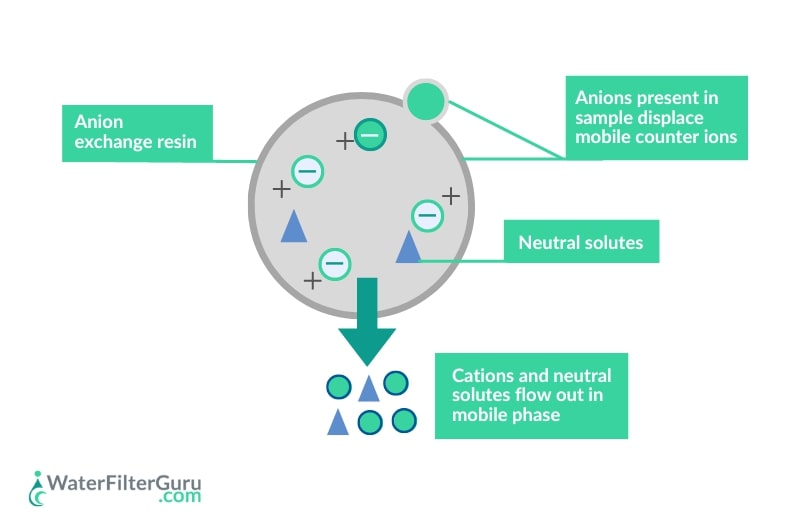
The Evidence
- This 2022 study evaluated the removal of tannins from cashew apple juice by a Tanex resin (a commercial blend of patented anion exchange resins for the removal of tannins). The study authors noted that the Tanex resin could be used to remove tannins from cashew apple juice with a high initial concentration of this compound.
- The Water Systems Council (WSC) also recommends anion exchange as one of the common tannin removal treatment methods for well water.
Best For
An anion exchange system is the best solution for folks with a water pH above 6 who want a whole-house tannin removal system that’s easy to maintain, doesn’t require cartridge changes, and removes tannins from a whole-house water supply.
⚗️ Reverse Osmosis
Reverse osmosis systems offer a highly capable water purification solution.
Tannins are high molecular weight organics, which means they can be effectively rejected by a semi-permeable RO membrane.
RO membranes are typically used in point-of-use (POU) systems, such as countertop and under-sink systems. Point of entry (POE) RO systems do exist, but they’re not the most popular choice because of their high upfront cost.
How it Works
Whole house reverse osmosis systems send water at a high pressure through a sediment pre-filter, a carbon filter, a RO membrane, and a post-filter cartridge.
What makes a reverse osmosis water filter so effective – not only at removing tannins, but also the majority of other dissolved solids – is its ability to treat and trap even the tiniest contaminants. This is thanks to the tiny pores in the RO membrane, which block most impurities of 0.0001 microns or larger.
As well as tannins, an RO treatment system removes bacteria, chemicals, and fluoride. The membrane also removes heavy metals like lead, and other contaminants that could turn water brown, such as iron.
Good to Know: Tannins can foul an RO membrane, reducing its performance efficacy and lifespan. For that reason, we only recommend using an RO system to remove tannins if your water contains lower concentrations of tannins (less than 1 PPM).
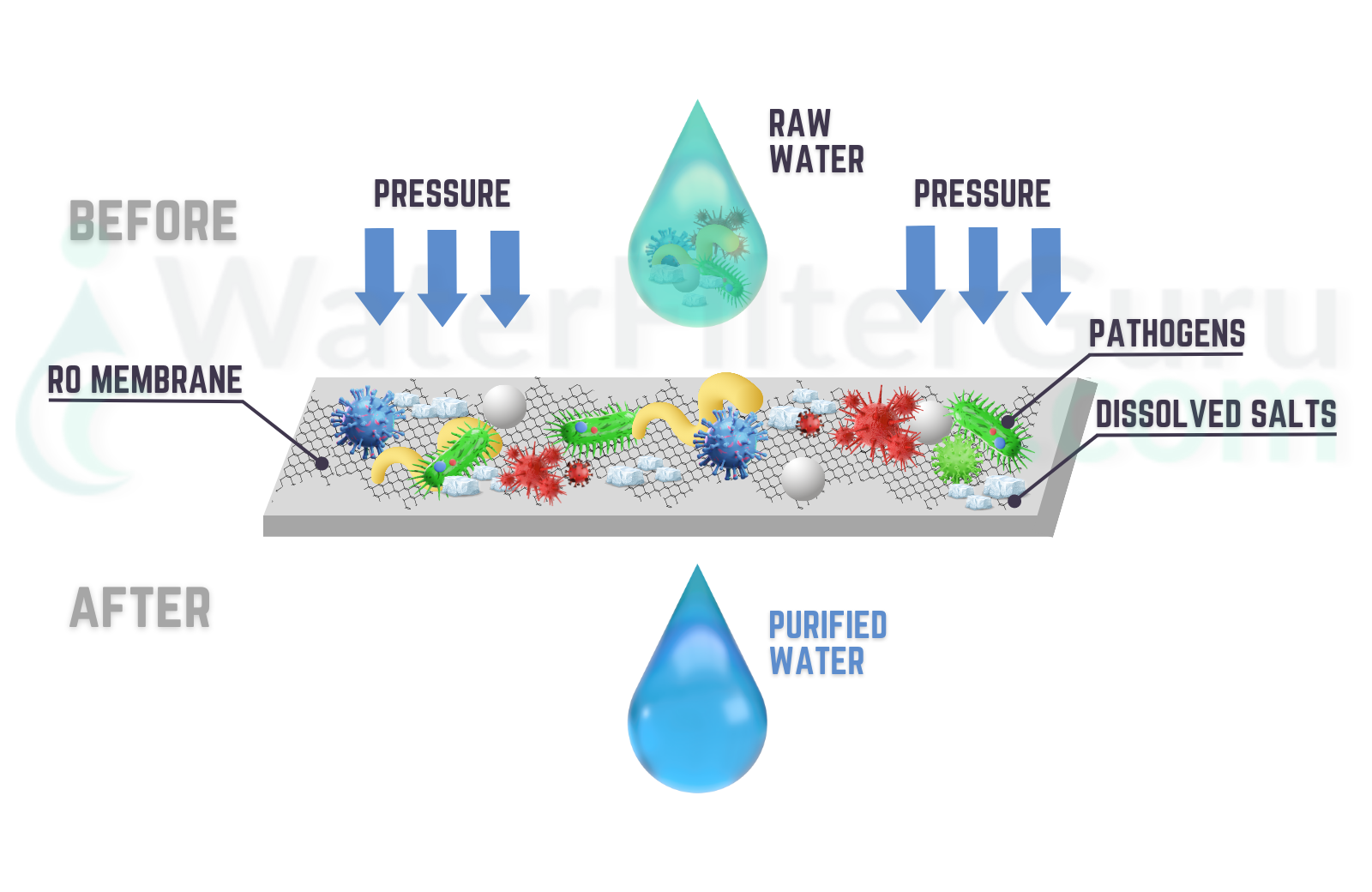
The Evidence
We were unable to find any studies that specifically evaluated the performance of RO systems for tannins removal. We also haven’t had the opportunity to test an RO system on a water supply containing tannins. Due to the lack of scientific evidence online, this is something we’ll look into doing soon.
Best For
Reverse osmosis systems are best for people with low levels of tannins in their water who want a comprehensive purification solution that removes tannins and most other dissolved solids. Due to the expense of POE RO systems, we recommend this technology to folks who just want to address tannins in their drinking water, not their whole house water supply.
We Recommend: US Water Systems Defender Whole House RO System
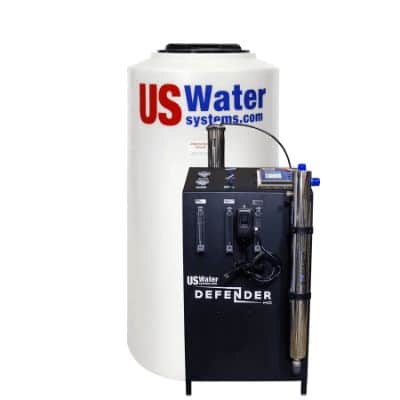
- Effectively removes tannins
- Highly efficient 5:1 produced to wastewater ratio
- 2,000 – 8,000 GPD production rate
- Customizable system
- Additionally removes up to 99.9% of total TDS
- Highly effective treatment system
📥 Oxidation
Finally, oxidation with air or chlorine/ozone followed by filtration is another method that can be effective at removing tannins.
However, a problem with using chlorine for this purpose is that it may react with tannin compounds in the water and produce various disinfection byproducts with toxic health effects.
How it Works
Oxidation systems oxidize tannins, converting them into an insoluble form that can be filtered out of water, usually with birm or manganese greensand media in the system tank.
These systems are primarily used for oxidizing and removing iron, manganese, and hydrogen sulfide.
The Evidence
We couldn’t find evidence that specifically evaluated the ability of chlorine or air injection systems to oxidize and remove tannins. However, we did find plenty of evidence that tannins in water can be oxidized, proving the method:
- This 2018 study’s results confirmed that tannic acid molecules were degraded and mineralized as a result of chemical oxidation from hydrogen peroxide and UV light.
- This 2020 review on tannis, including their extraction processes, noted that the water solubility of these impurities could be reduced by oxidation.
Best For
Given their ability to also oxidize and remove iron, sulfur, and manganese, oxidation systems are a great fit for well owners who want to remove tannins and these other common well contaminants.
🔮 Activated Carbon Filters
Activated carbon filters are particularly popular in the fishkeeping community for removing tannins from aquarium water.
These filters are widely used in water filtration devices, including water filter pitchers, under-sink filtration systems, and faucet filters.
How it Works
Activated carbon filters have a porous filtration media that captures contaminants using a process known as adsorption.
This technology is particularly effective at removing poor tastes and odors. It also offers partial removal of tannin discoloration in water.
Aside from tannins, activated carbon removes chlorine, some volatile organic compounds, PFAS, and some metals.
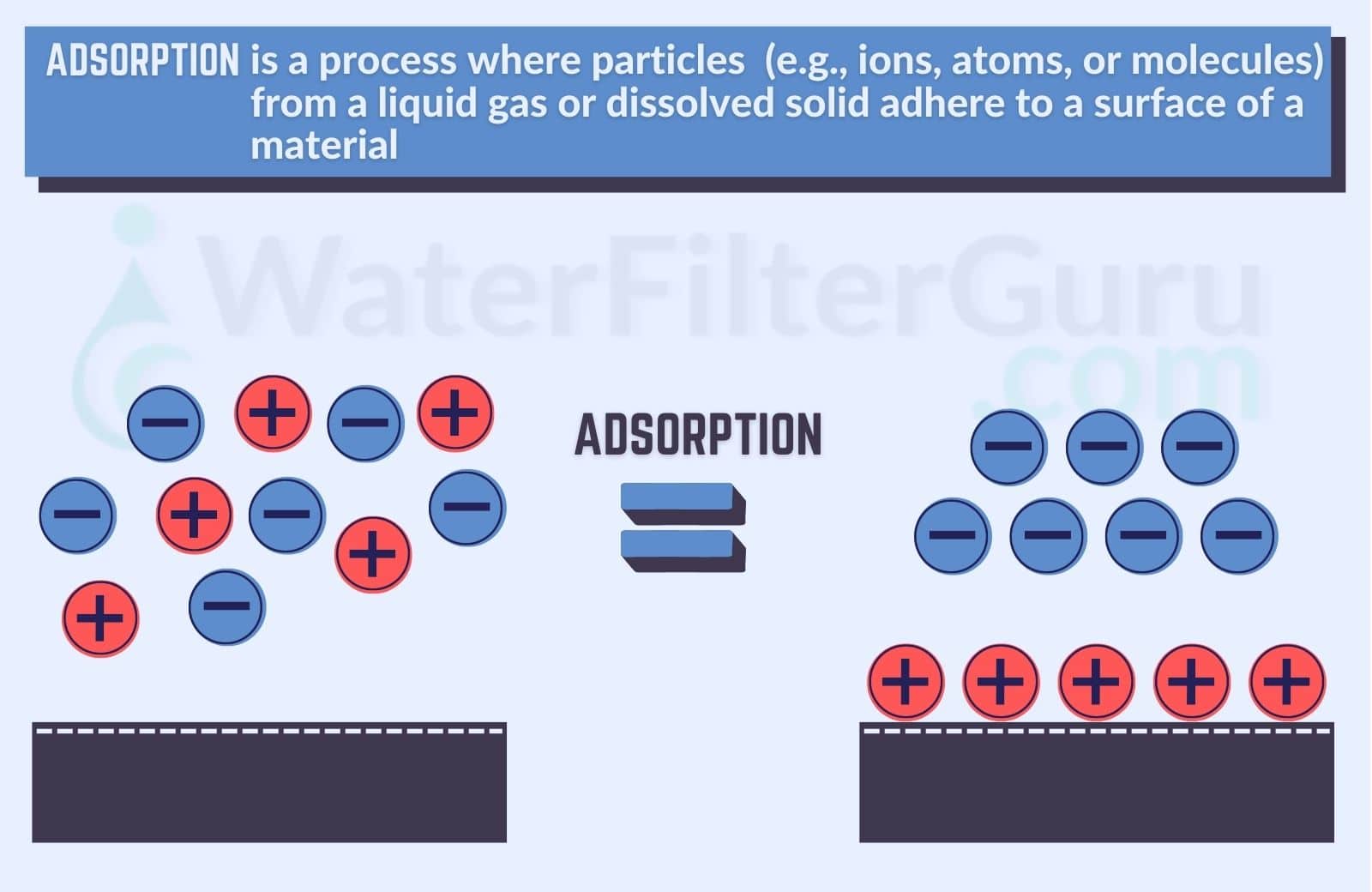
The Evidence
- One 2021 study on the adsorption removal of tannic acid by regenerated activated carbon found that regenerated activated carbon could remove 89.96% and 81.15% tannic acid at concentrations of 50 mg/L and 80 mg/L under optimal conditions.
- This 1997 study examined the adsorption of lignin and tannin color from aqueous solution onto activated charcoal, concluding that the sorption reaction was “of a first order” (excellent).
Best For
Activated carbon filters are the ideal affordable tannins removal solution for folks looking to eliminate the bitter or astringent taste associated with tannins contamination in their drinking water. Granular activated carbon is also a method to use instead of anion exchange if your water’s pH is less than 5.
🚰 Ultrafiltration Membranes
Ultrafiltration membranes are found in POE and POU systems and are used to purify and disinfect water.
They’re similar to reverse osmosis membranes, but their pores are larger, and they don’t remove TDS. Instead, they remove organic materials (including tannins), fine sediment, and microorganisms.
How it Works
Ultrafiltration membranes use membrane separation to block certain impurities from passing through their pores with water molecules. The typical pore size for a UF membrane is 0.02-0.05 microns.
The membrane will eventually become clogged and degraded and will need to be replaced, usually after 3-5 years.
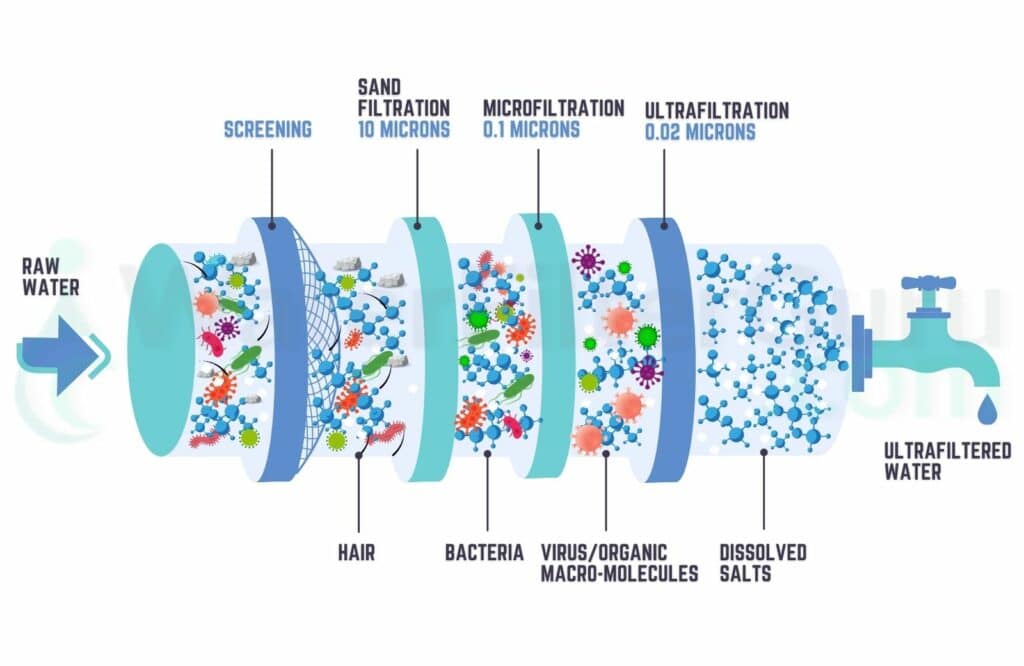
The Evidence
- This 2014 review on the removal of vegetable tannins from water in the leather industry cited a study with promising results: it noted that tannin removal using UF was “feasible”, although there was a high likelihood of membrane fouling issues due to “high concentrations of organic matter in effluents”.
Best For
Ultrafiltration is best for folks who want to address low levels of tannins with a water treatment method that’s almost as thorough as reverse osmosis, but doesn’t waste water and can be used with lower water pressure.
🔎 Other Solutions for Removing Tannins
There are several other methods that can be used to remove tannins from a water supply, but we don’t recommend them alongside our top solutions.
These include:
- Flocculation & filtration – Flocculation occurs when a flocculating agent is added to water, which causes particulates to clump together into larger masses called flocs. The flocs gather at the bottom of a water body and can then be filtered out more easily. Flocculation is used in water treatment plants to remove tannins, sediment, and organic matter, but it’s less commonly used in small-scale domestic applications, which is why it’s further down this list.
- Water distillation – Another purification method that effectively removes up to 100% tannins is water distillation. This process involves boiling water until it vaporizes, leaving the impurities (including the color-causing tannins) behind in the boiling chamber. An activated carbon filter is often used to address any lingering tastes and odors in the purified water. We don’t recommend distillation as a top method for a couple of reasons: it’s typically used to filter water after it has left a faucet, so it doesn’t protect your entire water supply from tannins staining; and it’s a very long process, taking up to 5 hours to distill a 1-gallon batch of water.
⚠️ Which Water Treatment Methods Are NOT Effective for Tannins Removal?
Tannins affect water’s taste, odor, color, and overall quality, and, due to their complex nature, there are many water treatment methods that won’t remove them from your water.
These include:
KDF Filters
KDF filters filter out chlorine, water-soluble heavy metals, and other dissolved impurities, but they don’t effectively remove tannins.
Conventional Water Softening
Not all types of ion exchange resin work to remove tannins. Water softeners use cation exchange, which won’t target tannins because (as we mentioned earlier) they’re anions. Anions are ions with a negative charge and can only be removed using an anion exchange resin.
Ceramic Filters
Tannins and their associated poor tastes, odors, and colors can pass through a ceramic filter, so it can’t be used effectively for this purpose.
Boiling Water
Boiling your water will only cause some of the water to evaporate, and won’t make a difference to its dissolved tannins concentration. The only way to remove tannins from water by boiling is to condense and collect the water vapor in a separate container (distillation).
📝 Final Word
We hope this article has helped you to decide on how to remove tannins from water in your own home.
To reiterate what we said in the intro to this guide, there are dozens of types of tannins that could be present in your water, and one method of water treatment alone may not offer a complete tannins removal solution.
Our advice is to start with a dedicated tannins removal system, like the SpringWell Tannin Removal System & Softener. This gives you the best chance of comprehensively tackling tannins in your water with a system that’s solely designed for this purpose.
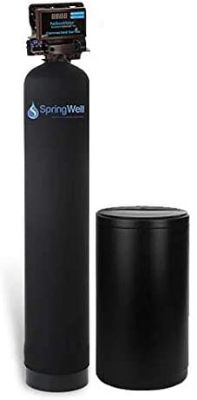
Springwell Tannin Softener System
You’ll struggle to find an all-in-one tannin removal and softening solution on the market, and that’s what makes the SpringWell Tannin Softener System such a unique find.
